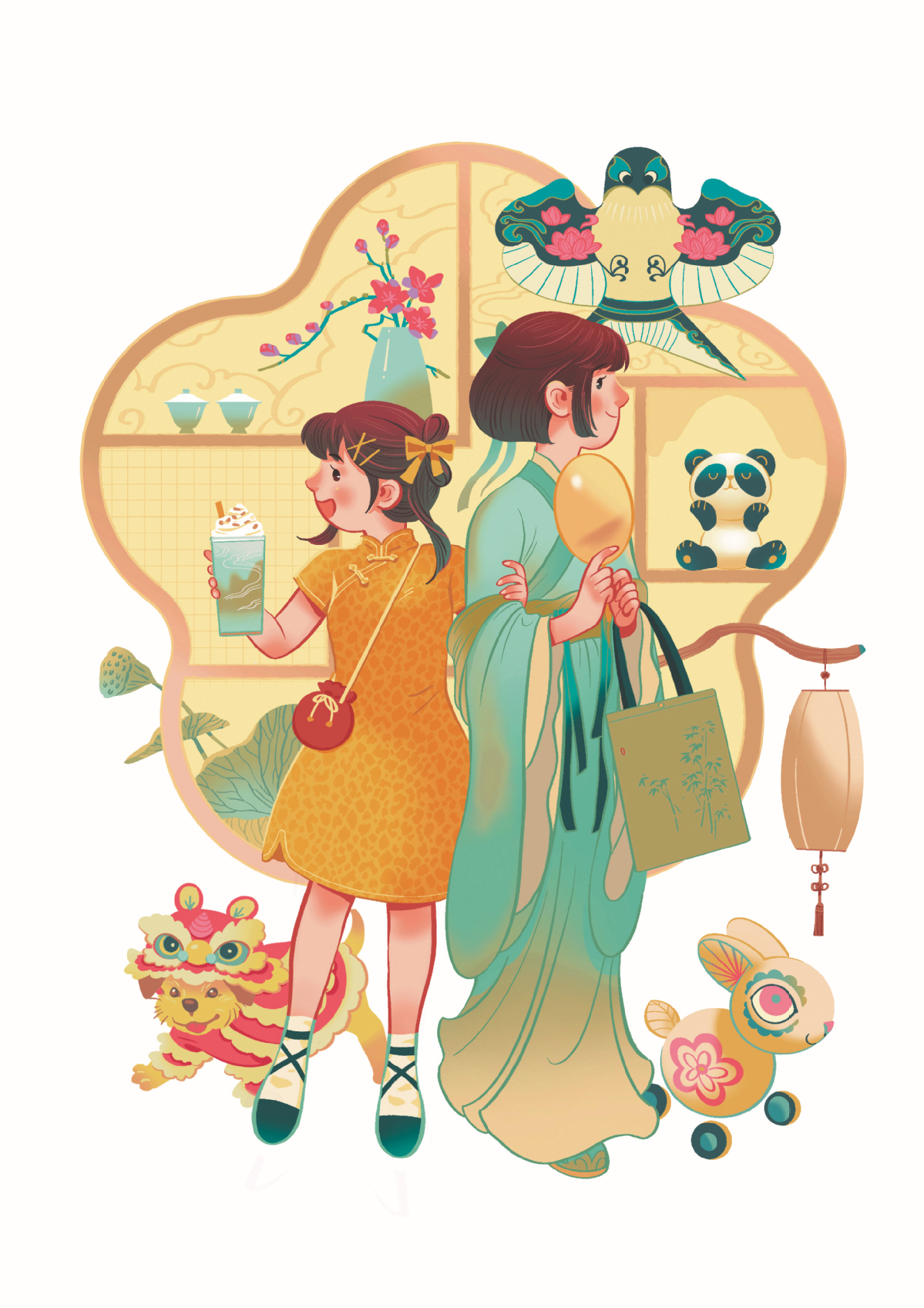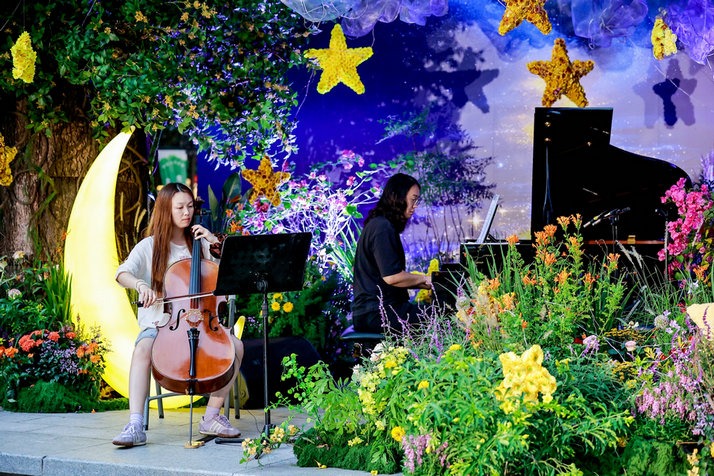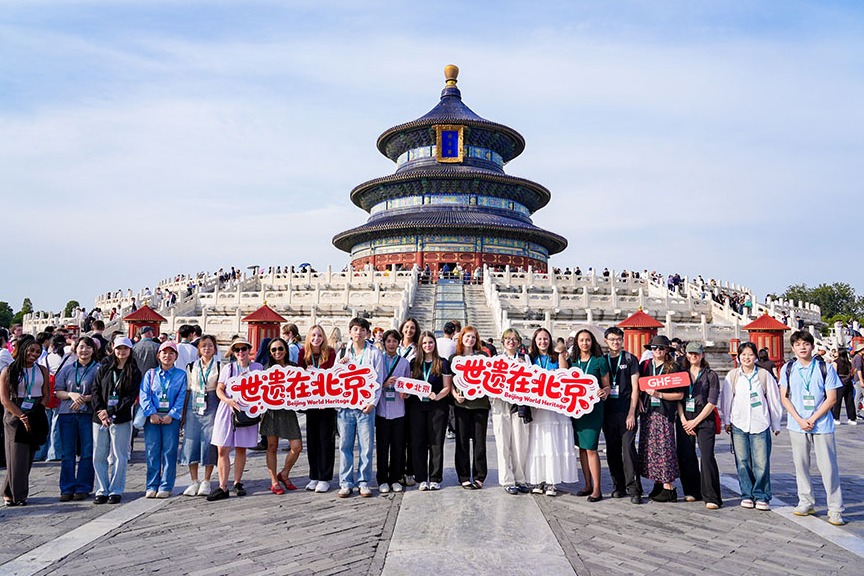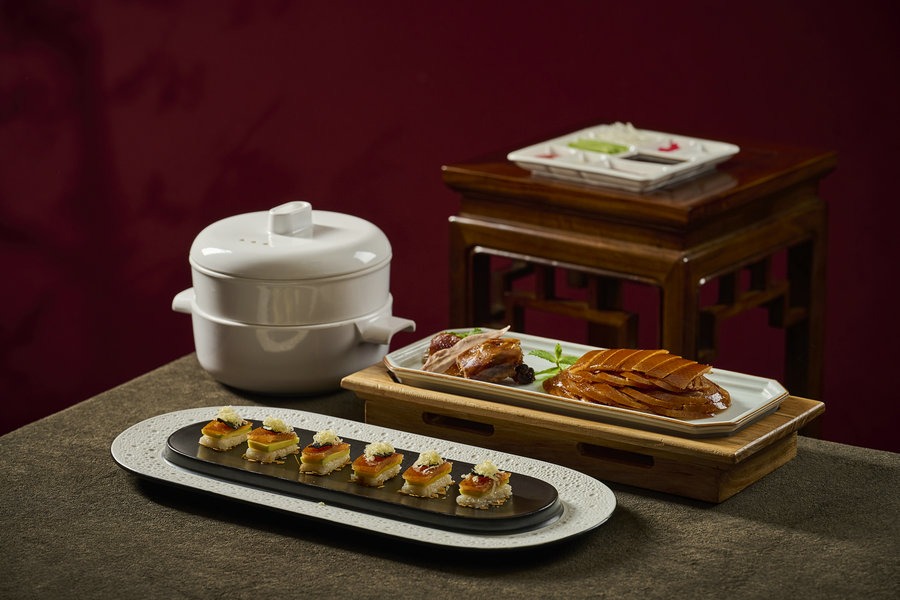New Chinese style gives young people a cool everyday choice
Innovative, traditional design grows in popularity as more consumers enjoy both its practicality and fashion


As people walk through the crowd along the buzzing Pingjiang Road in downtown Suzhou, East China's Jiangsu province, they'll often see women clad in various styles of qipao (cheongsam) and hanfu (traditional Chinese dresses).
Photographer Zhang Xiyan is busy capturing a mother and daughter in pretty hanfu outfits. Amid the constant flow of people, she seeks the best angles for her shots. Interestingly, behind the camera, Zhang herself wears a qipao dress.
The 32-year-old photographer wears a qipao every day of the year, owning about 20 such dresses. She chooses a piece of different material and thicknesses according to the seasons. "It's convenient for everyday wear," she says.
"I don't feel awkward wearing qipao on the streets," Zhang says."Suzhou is a magical city. Living here, people will start to love the traditional styles of costumes and also enjoy traditional cultural activities like tea drinking and playing the guqin (a traditional seven-stringed zither)."
In cities like Suzhou, Hangzhou of East China's Zhejiang province, and Luoyang of Central China's Henan province, the trend of wearing hanfu for photos and social media check-ins is on the rise. New Chinese style (xinzhongshi) is becoming a popular everyday choice among young people, who are increasingly adopting this style across various aspects of their lives, from apparel to dining, living, and traveling. The fusion of traditional Chinese elements with modern design is often referred to as xinzhongshi, or the "new Chinese style", which has been gaining popularity both in products and activities.
This spring, women's clothing stores are showcasing a variety of new Chinese-style items, featuring traditional designs like knot buttons, cloud patterns, and horse-face skirts (mamianqun in Chinese), a type of traditional Chinese skirt characterized by its distinct pleated design. The trend extends beyond apparel, with a growing market for domestic beauty and cultural products as well as home goods, and food inspired by new Chinese style.
According to last year's Chinese Brand Consumption Trend Report, released by JD Research Institute for Consumption and Industrial Development, the number of Chinese consumers buying guochao — "National tide" or "China chic", a consumption trend wherein younger consumers prefer products with Chinese cultural elements — products grew by 74 percent between 2019 and 2022, while sales surged by 355 percent.
Six years ago, Zhang left her hometown in Fujian province and settled in Suzhou, drawn by her passion for traditional Chinese gardens and ancient architecture. Since then, she has been working as a freelance photographer.
Most of her photo shoots took place on Pingjiang Road and in the Humble Administrator's Garden (Zhuozheng Yuan), first built in the Ming Dynasty (1368-1644).
In the past two years, she has witnessed more young women wearing hanfu walk on Pingjiang Road, and many of them come to scenic spots clad in the traditional Chinese dresses for photos.
"There are more than 20 rental shops in a small alley near the main lane of Pingjiang Road," Zhang says. "The garments come in various styles, from traditional replicas to more modern interpretations, catering to different tastes."
Zhang meets up regularly with friends, all clad in such dresses, for tea sessions. Apart from enjoying the drink, they also partake in traditional activities, such as incense burning and flower arrangements. Her friends each have different talents pertaining to traditional Chinese culture, some good at playing the guqin, while some are flower arrangement masters. "It's a community where we learn and share skills with one another," she says.
Zhang likes qipao so much that she even spends her spare time sewing them. She has already made 10 such dresses for herself. She even planned to launch workshops guiding others how to make them in the future or be a tailor herself.
Sold out
Unlike the photographer, 48-year-old Zhang Ying was born into a family of tailors. After graduating from a vocational college in Guangdong province with a degree in fashion design in 2000, she ventured to Shanghai and started her own cheongsam studio.
"My mom and grandma were tailors. Sometimes they would spend days making qipao for clients at their homes," Zhang Ying recalls. "I've loved making clothes since I was young. I used to cut up my mom's clothes to make outfits for my younger sister."
Her Shanghai Jianjie qipao-making factories, focusing on keywords of xinzhongshi and qipao, have grown steadily over the past 20 years, employing more than 300 people at its peak. During the pandemic, she closed one factory and now has a tailoring team of over 40 people.
But with the recent surge in demand for new Chinese-style clothing in China, her products are sold out. With an annual turnover reaching 100 million yuan ($13.8 million), she has decided to further expand her team.
Over the past two decades, while inheriting traditional qipao-making techniques from her family, she has continually refined the design and color combinations of her cheongsam, making them more fashionable and convenient for customers.
In recent years, she has also been innovating in fabric development, personally weaving and dyeing all the fabrics used in her clothing.
As of early February, there were over 2.6 million notes on Xiaohongshu social media platform related to the hashtag topic of "new Chinese-style dressing", and the same topic has garnered a total of 10.2 billion views on Douyin, a short-video sharing platform.
Zhang Ying has noticed this sudden boom in the popularity of xinzhongshi clothing. She has directly felt this surge through the sales in her Douyin livestreams.
"In these livestreams, customers sometimes get into arguments trying to grab a piece of our clothes. I used to plan two livestreaming sessions a day to sell my products, but my team informed me that we had run out of clothes in the warehouse," she says.
She says she found that when customers visit her studio to try on clothes, without paying for them yet, they often hold onto these items they like, for fear that they might get snatched up by someone else.
"Just the other day, a customer from Kunming, Southwest China's Yunnan province, came to my studio, tried on some clothes, and ended up buying 37 pieces at once. Many of my customers are repeat buyers," she adds.
Zhang Ying has noticed a trend: Many people are now buying xinzhongshi clothing for everyday wear, and it's becoming common to spot them on the streets of Shanghai. "In the past, most of my orders were for special occasions like weddings, about 80 percent. Only 20 percent were for daily wear. But now, it's the opposite," she says.
Last year, she made a batch of xinzhongshi clothing for men, and they sold out quickly. She mentions that there is also a high demand for men's new Chinese-style clothing, but she currently doesn't have enough capacity to meet it.
At the 2024 MODE Shanghai Fashion Trade Show, a key event of the Shanghai Fashion Week held in March, brands embracing Chinese-style fashion and national trends made up 25 percent of the independent exhibitors this season.
Zhang Ying sees this as a natural trend, stating, "now is the ideal time to showcase xinzhongshi clothing because more young people have become more confident in Chinese culture".
Despite the rise of many new brands, she believes the new Chinese-style clothing sector is entering a phase of intense competition.
Tong Jisheng, director of the Shanghai Fashion Week Organizing Committee, says that designers need to produce more innovative xinzhongshi garments to lead the fashion trends, while also make products accessible to greater numbers of ordinary consumers, allowing more people to appreciate and afford them.
Data from the China National Textile and Apparel Council shows that in 2023, China's xinzhongshi clothing market surged to a staggering 1 billion yuan, and over the past three years, the total transaction volume of related products has grown at a rate exceeding 100 percent.
More fields
Social media has played a significant role in boosting the popularity of Zhang Ying's new Chinese-style clothing online with more customers knowing about her brand through Douyin. Meanwhile, offline, the allure of new Chinese-style home decor is gradually gaining attention in the homes, stores and office spaces.
In the realm of xinzhongshi furniture, there's no exact definition. For today's young consumers, it's about creatively blending Chinese traditional elements with modern aesthetics to suit contemporary tastes, according to many home decor experts.
In Beijing's Daxing district stands the Tianwu Art Center, which was completed just last year. Since its opening, many visitors have been drawn to explore tangible examples of the xinzhongshi home decor styles on display.
Ma Yuchen, the center's general manager, explains that it serves as a showcase for their unique Chinese-style design aesthetic and lifestyle. Moreover, it's an open space that hosts exhibitions featuring innovative guochao brands and avant-garde artists.
"For years, we've been dedicated to Tianwu, a brand specializing in new Chinese-style furniture," Ma says.
The brand's founder, Zhong Song, infuses his designs with Chinese cultural elements, emphasizing the aesthetic of harmony between people, nature and space.
"Many visitors find our center a tranquil and comfortable space, where they'd feel free and at ease," Ma says.
Ma sees a gradual increase in the customer base for xinzhongshi home decor products, with young people, who have just bought their first homes, becoming the main consumers. "After they have their own homes, they hope to create their ideal living spaces and express themselves through their spaces."
In another tantalizing field, new Chinese-style cuisine is also becoming more popular across China, with a variety of offers appearing on diners' tables, including both refined presentations of traditional Chinese dishes and the fusion of Chinese ingredients and flavors into Western cuisine.
After studying Western culinary arts in Switzerland, 34-year-old Cai Jiahao returned to Beijing and opened his restaurant, Les Morilles, in 2017. Over seven years, he's developed his own cooking style by incorporating local Chinese elements into his dishes, creating new combinations.
"Some seasoning methods and ingredients in China are unique and not found abroad," Cai explains, adding that "Chinese diners prefer lighter tastes compared to the rich flavors of traditional Western cuisine".
Les Morilles recently introduced a spring menu named Coucou in French, featuring eight courses. Using ingredients like king crab, scallop, lobster, and Wagyu beef as a base, Cai adds seasonal domestic ingredients and seasonings to highlight the freshness of spring, such as Fujian green asparagus, Shandong white asparagus, and Jiangsu pomelo.
"Lobster pairs well with refreshing pomelo, enriching the dish's flavor," Cai shares.

































